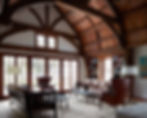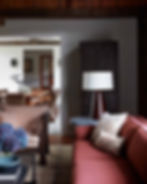







Although the bones of this Connecticut country house date to the early 1700s, additions both historic and contemporary have enlarged the structure far beyond the scale typical of the period. A lofty nineteenth-century barn, for example, was attached to the main building in the 1930s. After living in the UK for several years, my young clients had returned to the United States with their new baby, intent on purchasing their first home. In all, the house encompasses 8,500 square feet, and since they arrived with only two pieces of furniture—a vintage trunk and a Danish desk—we had our work cut out for us. The homeowners and I weren’t interested in a slavish reproduction of a classic Colonial house. Instead, we wanted a more nuanced scheme that embraces American archetypes along with elements of Scandinavian design and contemporary pieces closer in age and sensibility to the clients’ art collection. That spirit is perhaps best exemplified in the great room, which now occupies the former barn; this space set the tone for the rest of the house, in terms of both color and materials.
The warm wood of the barrel vault was my starting point for a palette that includes rusty reds, pumpkin, and, reflecting the cool hues of the fieldstone fireplace, complementary silvery blues. Our principle for selecting furniture excluded anything too decorative; at its roots, the house is a simple farmhouse, and the pieces had to embody an honesty of form and be comfortable. The furnishings incorporate Arts and Crafts sofas and chairs by Paine, two vintage wingback chairs in red leather, and industrial elements such as a cast-iron coffee table that nods to the barn’s utilitarian nature. In the dining room, I surrounded a classic Stickley Mission dining table—the first piece my clients purchased for their new home—with a suite of chairs by French artist Pierre Abadie. The style collision of the traditional wood table and the sculptural folded- steel chairs creates a dialogue between the past and the present, sparking an aesthetic tension that lifts the project beyond a dry exercise in historical accuracy. Other modern additions—an Alvar Aalto chair in the entry, Hans Wegner wingback chairs in the library, Charlotte Perriand stools in the kitchen—generate a similar type of creative friction. With the placement of the clients’ art collection, which includes prominent works by Jack Pierson, Carroll Dunham, Gregory Crewdson, Elmgreen & Dragset, and Harland Miller, the duel between the modern and traditional kicks into overdrive.
Project Notes




















Project Notes
Although the bones of this Connecticut country house date to the early 1700s, additions both historic and contemporary have enlarged the structure far beyond the scale typical of the period. A lofty nineteenth-century barn, for example, was attached to the main building in the 1930s. After living in the UK for several years, my young clients had returned to the United States with their new baby, intent on purchasing their first home. In all, the house encompasses 8,500 square feet, and since they arrived with only two pieces of furniture—a vintage trunk and a Danish desk—we had our work cut out for us. The homeowners and I weren’t interested in a slavish reproduction of a classic Colonial house. Instead, we wanted a more nuanced scheme that embraces American archetypes along with elements of Scandinavian design and contemporary pieces closer in age and sensibility to the clients’ art collection. That spirit is perhaps best exemplified in the great room, which now occupies the former barn; this space set the tone for the rest of the house, in terms of both color and materials. The warm wood of the barrel vault was my starting point for a palette that includes rusty reds, pumpkin, and, reflecting the cool hues of the fieldstone fireplace, complementary silvery blues.
Our principle for selecting furniture excluded anything too decorative; at its roots, the house is a simple farmhouse, and the pieces had to embody an honesty of form and be comfortable. The furnishings incorporate Arts and Crafts sofas and chairs by Paine, two vintage wingback chairs in red leather, and industrial elements such as a cast-iron coffee table that nods to the barn’s utilitarian nature. In the dining room, I surrounded a classic Stickley Mission dining table—the first piece my clients purchased for their new home—with a suite of chairs by French artist Pierre Abadie. The style collision of the traditional wood table and the sculptural folded- steel chairs creates a dialogue between the past and the present, sparking an aesthetic tension that lifts the project beyond a dry exercise in historical accuracy. Other modern additions—an Alvar Aalto chair in the entry, Hans Wegner wingback chairs in the library, Charlotte Perriand stools in the kitchen—generate a similar type of creative friction. With the placement of the clients’ art collection, which includes prominent works by Jack Pierson, Carroll Dunham, Gregory Crewdson, Elmgreen & Dragset, and Harland Miller, the duel between the modern and traditional kicks into overdrive.
